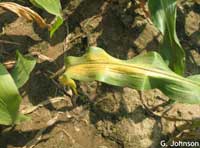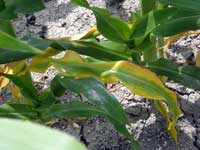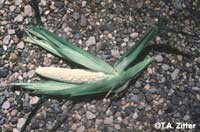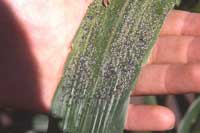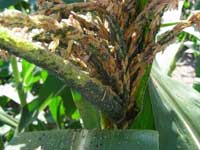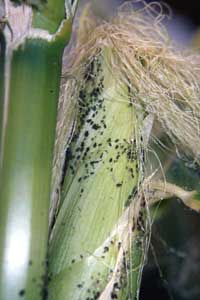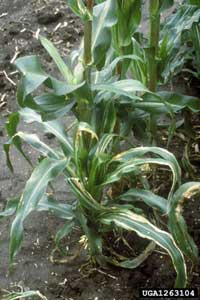Extension > Garden > Diagnose a problem > What's wrong with my plant? > Vegetable > Sweet Corn > Discolored leaves
Sweet corn > Leaves > Discolored leaves
1 of 6
Nitrogen Deficiency
- Overall plant color is a pale green
- Yellowing of lower leaves in a V pattern from the tip backward
- Leaves may turn completely brown and die
- Plant may be stunted
- More information on Nitrogen Deficiency
2 of 6
Potassium Deficiency
- Lower leaves show yellowing that starts at the tip
- Leaf edges may become brown
- Plant may be stunted
- More information on Potassium Deficiency
3 of 6
Phosphorus Deficiency
- Leaves are narrow and may have a bluish tint
- Tips of the upper leaves eventually turn purple
- Plant may be stunted
- More common following a cold, wet spring
- More information on Phosphorus Deficiency
4 of 6
Virus
Dwarf mosaic and maize chlorotic dwarf
- Leaves have light and dark green mottling or streaks
- Infected plants are stunted and may produce many tillers
- Plants may not produce an ear, or ear is poorly developed
- More information on Virus
5 of 6
Corn Leaf Aphid
Rhopalosiphum maidis
- Exude a sticky, shiny substance called "honeydew"
- Large numbers can occur on tassels
- Large numbers may cause curling leaves or yellow discolorations on the leaves
- Aphids are blue-green to gray and are small (1/8 inch or less), soft-bodied, and pear-shaped
6 of 6
Stewart's Wilt
Pantoea stewartii
- Plants infected early in the season wilt, remain stunted, and may die
- Plants infected late season have pale-green to yellow streaks with wavy edges run parallel to the leaf veins
- Older leaves may have scorched brown edges
- Cut stalks exude a yellow sticky bacterial slime
- Occurs rarely in Minnesota
- More information on Stewart's Wilt



